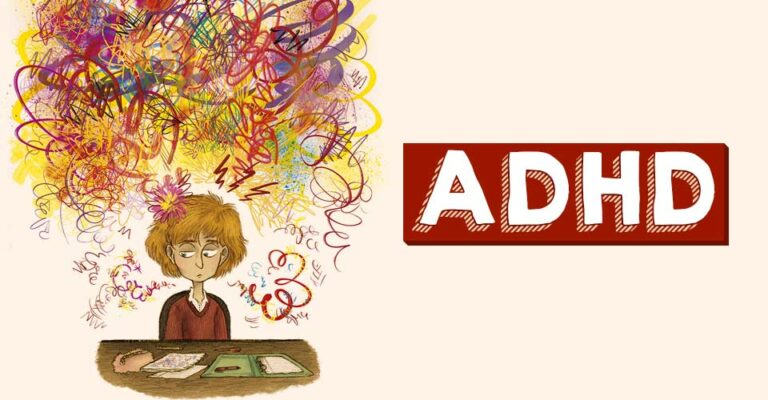
“ADHD Unveiled: Navigating the Intricacies of Attention-Deficit/Hyperactivity Disorder”
To begin with,
People of all ages are affected by Attention-Deficit/Hyperactivity Disorder (ADHD), a complex ailment within the complex field of neurodevelopmental illnesses. This essay aims to investigate the complicated world of ADHD, exposing its different symptoms, looking into possible origins, and providing helpful guidance on understanding and treating this common condition. We give you a comprehensive overview of the complexities of ADHD, from its early onset in childhood to its continuing effects on social, intellectual, and career aspects of life.
Understanding ADHD
ADHD is characterized by hyperactivity, impulsivity, and recurring patterns of inattention. Though most commonly associated with childhood, the condition also regularly affects adolescents and adults, presenting unique challenges at each developmental stage. It manifests in many subgroups, including predominantly inattentive, predominantly hyperactive-impulsive, and a mixture presentation, which show the spectrum of its various symptoms.
The Spectrum of ADHD:
ADHD is not a diagnosis that fits everyone; rather, it is a spectrum disorder with a variety of appearances. The mostly inattentive subtype has trouble focusing, organizing activities, and completing tasks. Conversely, the predominant hyperactive-impulsive subtype is characterized by restlessness, rash decisions, and difficulty waiting one’s turn. The combination of hyperactivity-impulsivity and inattentiveness is captured in the mixed presentation. It is crucial to comprehend this range in order to adapt therapy to meet the specific demands of each individual.
Factors Contributing to ADHD:
The complex etiology of ADHD entails the interplay of neurological, environmental, and genetic factors. Genetic susceptibility, estimated to be between 70 and 80% heritable, is significant. Two prenatal and perinatal factors that increase the risk of ADHD include premature birth and chemical exposure. The illness’s neurodevelopmental nature is highlighted by neurobiological components, such as dopamine and norepinephrine abnormalities.
The Neurobiology of ADHD:
Neurobiological mechanisms have a major influence on how ADHD manifests. Important brain regions like the striatum and the prefrontal cortex have been shown to exhibit structural and functional abnormalities in patients with ADHD. The main symptoms of the disease are thought to be caused by an imbalance of neurotransmitters, particularly dopamine, which is necessary for impulse control and attention. Understanding the brain underpinnings provides the foundation for developing targeted treatments and pharmacological solutions.
The Psychosocial Aspects of ADHD:
The experience of ADHD is influenced by both neurobiological and psychosocial variables. Academically, ADHD patients usually struggle because they can’t concentrate for long periods of time, stay organized, or manage their time well. Problems with establishing and maintaining relationships could surface and affect social interactions. The amount of complexity increases when ADHD coexists with other conditions like anxiety and depression. Psychosocial therapies such as academic modifications and behavioral treatment are critical to the management of full-spectrum ADHD.
Effects on Academic and Workplace Performance:
ADHD significantly affects both professional and academic functioning. It may be challenging for people with ADHD to concentrate during class, complete homework, and effectively manage their time in a learning environment. As children grow older and enter the workforce, they encounter new obstacles related to time management, productivity, and organization. It is necessary to identify and address these barriers early on in order to support success in academic and professional endeavors.
Assessment and Prognosis:
A precise diagnosis and a comprehensive evaluation are necessary for comprehending and managing ADHD. Diagnosis requires a thorough evaluation of the patient’s behavioral observations, medical history, and symptoms. Rating scales and neuropsychological assessments are two types of objective measurements that provide further details about cognitive functioning. The diagnostic procedure should be collaborative and involve input from educators, parents, and healthcare professionals to ensure a thorough assessment of each person’s strengths and weaknesses.
Techniques of Care:
In ADHD therapy, a multimodal approach that is tailored to each patient’s unique needs is commonly employed. Behavioral therapies, including psychoeducation, organizational skills training, and behavioral therapy, are intended to address specific challenges associated with ADHD. Pharmacological therapies, such as stimulant and non-stimulant medications, can be used to treat symptoms. A person’s preferences, medical history, and potential side effects should all be considered before determining whether to take medication.
Lifestyle and Self-Management Strategies:
In addition to formal therapy, self-management strategies and lifestyle modifications are critical for managing ADHD. Establishing routines, breaking tasks down into manageable chunks, and getting regular exercise might help improve focus and impulse control. A balanced diet, stress management techniques, and adequate sleep are all important for overall health. Promoting self-awareness and the creation of helpful coping strategies helps individuals with ADHD cope better with the challenges posed by the disorder.
fostering environments and resources for education
Establishing a supportive environment is essential for the successful development of individuals with ADHD. Extended exam periods, preferred seating, and organizational support are examples of accommodations that help level the playing field in educational settings. Parents and educators are crucial in fostering tolerance, understanding, and adaptation. The effectiveness of support networks and interventions is increased when educators, parents, mental health professionals, and the individual with ADHD collaborate.
Consciousness and Promotion:
Debunking myths, reducing stigma, and promoting understanding about ADHD require advocacy work and more public awareness. People with ADHD can feel more accepted and supported when they are in an educated and caring group. Advocacy include policy changes that ensure equitable access to healthcare, education, and job accommodations. Together, we can create a society that is more caring and understanding of those who suffer from ADHD.
In conclusion,
It should be highlighted that ADHD is a complex neurodevelopmental disorder that calls for in-depth understanding and specific therapies. Because ADHD affects many aspects of life and has a wide range of symptoms, treatment must be well-coordinated and advanced. People with ADHD can overcome the unique challenges they confront, reach their full potential, and make significant contributions to society by treating the biological, psychological, and social aspects of the disorder. By undertaking more research, pushing for reforms, and increasing awareness of the problem, we can foster a more accepting and supportive environment for those who suffer from ADHD.